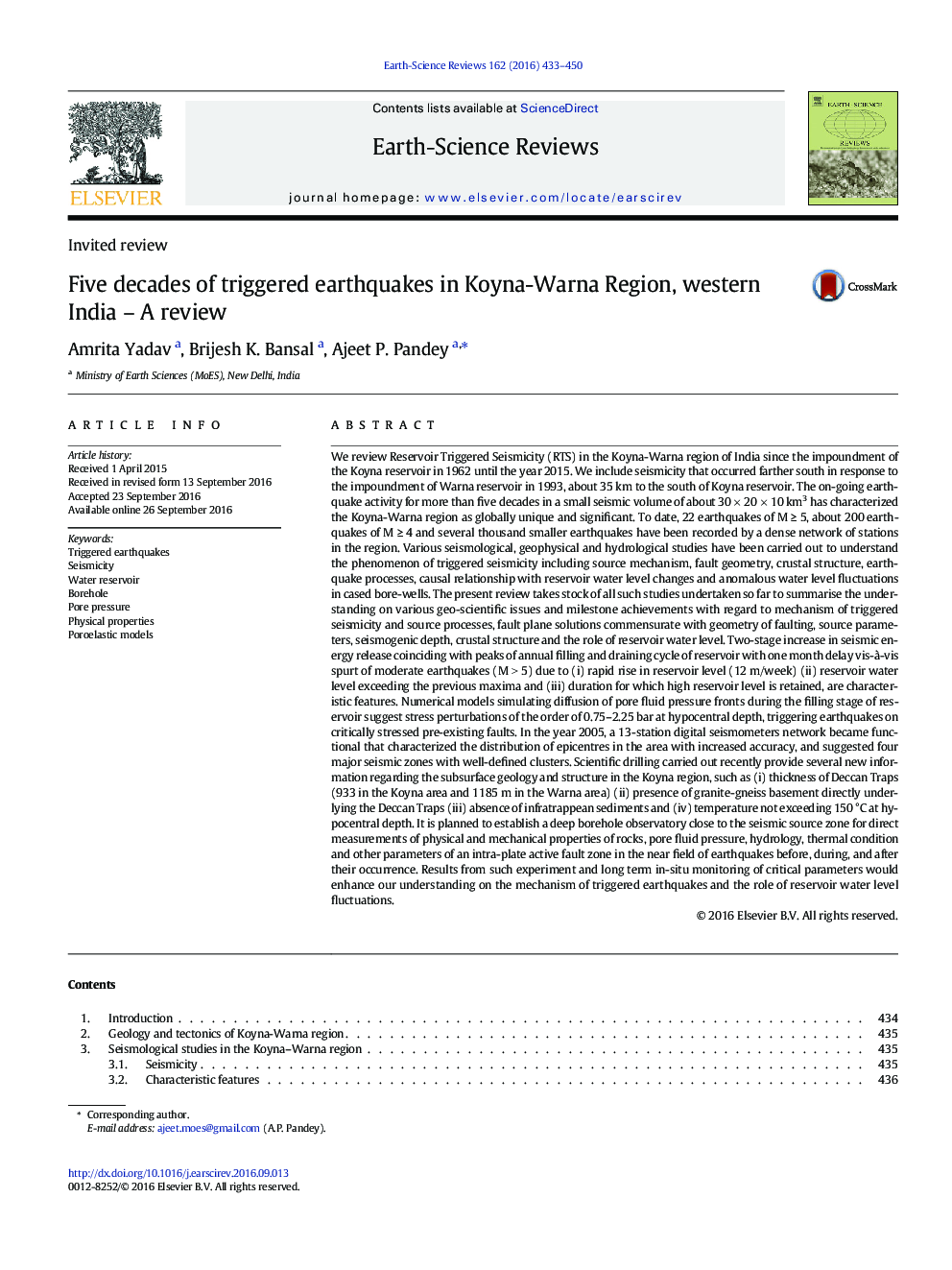| کد مقاله | کد نشریه | سال انتشار | مقاله انگلیسی | نسخه تمام متن |
|---|---|---|---|---|
| 6442781 | 1639940 | 2016 | 18 صفحه PDF | دانلود رایگان |
عنوان انگلیسی مقاله ISI
Five decades of triggered earthquakes in Koyna-Warna Region, western India - A review
ترجمه فارسی عنوان
پنج دهه از زمین لرزه ها در منطقه کوینا-وارنا، غربی هند - بررسی شد
دانلود مقاله + سفارش ترجمه
دانلود مقاله ISI انگلیسی
رایگان برای ایرانیان
کلمات کلیدی
زلزله های متضاد، لرزه خیزی، مخزن آب گمانه فشار بخار، مشخصات فیزیکی، مدل های پراستفاده،
موضوعات مرتبط
مهندسی و علوم پایه
علوم زمین و سیارات
زمین شناسی
چکیده انگلیسی
We review Reservoir Triggered Seismicity (RTS) in the Koyna-Warna region of India since the impoundment of the Koyna reservoir in 1962 until the year 2015. We include seismicity that occurred farther south in response to the impoundment of Warna reservoir in 1993, about 35 km to the south of Koyna reservoir. The on-going earthquake activity for more than five decades in a small seismic volume of about 30 Ã 20 Ã 10 km3 has characterized the Koyna-Warna region as globally unique and significant. To date, 22 earthquakes of M â¥Â 5, about 200 earthquakes of M â¥Â 4 and several thousand smaller earthquakes have been recorded by a dense network of stations in the region. Various seismological, geophysical and hydrological studies have been carried out to understand the phenomenon of triggered seismicity including source mechanism, fault geometry, crustal structure, earthquake processes, causal relationship with reservoir water level changes and anomalous water level fluctuations in cased bore-wells. The present review takes stock of all such studies undertaken so far to summarise the understanding on various geo-scientific issues and milestone achievements with regard to mechanism of triggered seismicity and source processes, fault plane solutions commensurate with geometry of faulting, source parameters, seismogenic depth, crustal structure and the role of reservoir water level. Two-stage increase in seismic energy release coinciding with peaks of annual filling and draining cycle of reservoir with one month delay vis-à -vis spurt of moderate earthquakes (M > 5) due to (i) rapid rise in reservoir level (12 m/week) (ii) reservoir water level exceeding the previous maxima and (iii) duration for which high reservoir level is retained, are characteristic features. Numerical models simulating diffusion of pore fluid pressure fronts during the filling stage of reservoir suggest stress perturbations of the order of 0.75-2.25 bar at hypocentral depth, triggering earthquakes on critically stressed pre-existing faults. In the year 2005, a 13-station digital seismometers network became functional that characterized the distribution of epicentres in the area with increased accuracy, and suggested four major seismic zones with well-defined clusters. Scientific drilling carried out recently provide several new information regarding the subsurface geology and structure in the Koyna region, such as (i) thickness of Deccan Traps (933 in the Koyna area and 1185 m in the Warna area) (ii) presence of granite-gneiss basement directly underlying the Deccan Traps (iii) absence of infratrappean sediments and (iv) temperature not exceeding 150 °C at hypocentral depth. It is planned to establish a deep borehole observatory close to the seismic source zone for direct measurements of physical and mechanical properties of rocks, pore fluid pressure, hydrology, thermal condition and other parameters of an intra-plate active fault zone in the near field of earthquakes before, during, and after their occurrence. Results from such experiment and long term in-situ monitoring of critical parameters would enhance our understanding on the mechanism of triggered earthquakes and the role of reservoir water level fluctuations.
ناشر
Database: Elsevier - ScienceDirect (ساینس دایرکت)
Journal: Earth-Science Reviews - Volume 162, November 2016, Pages 433-450
Journal: Earth-Science Reviews - Volume 162, November 2016, Pages 433-450
نویسندگان
Amrita Yadav, Brijesh K. Bansal, Ajeet P. Pandey,
